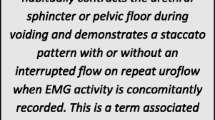Summary
Over a 2-year period, 401 patients with urinary incontinence were examined at the Women's Clinics in Lund and Malmö and then investigated by urethral pressure profile measurement and simultaneous urethrocystometry. After full investigation the patients could be classified as follows: 214 (53.4%) had genuine stress incontinence, 48 (12.0%) had genuine urge incontinence, 41 (10.2%) had mixed incontinence, 20 (5.0%) had urgency-frequency, 6 (1.5%) had neurogenic incontinence, 9 (2.2%) had incontinence of uncertain aetiology, and 63 (15.7%) of the patients were apparently continent with normal urethral pressure profiles and urethrocystometrograms.
Similar content being viewed by others
References
Bailey KV (1956) A clinical investigation into uterine prolapse with stress incontinence. Treatment by modified Manchester colporhaphy, Part II. Br J Obstet Gynaecol 63: 663
Bates CP, Whiteside CG, Turner-Warwick R (1970) Synchronus cinepressureflowcystourethrography with special reference to stress and urge incontinence. Br J Urol 42: 714
Drutz HP, Schapiro BJ, Mandel F (1978) Do static cystourethrograms have a role in the investigation of female incontinence? Am J Obstet Gynecol 130: 516
Fantl JA, Hurt WG, Dunn LJ (1977) Dysfunctional detrusor control. Am J Obstet Gynecol 129: 229
Greenwald SW, Thronbury JR, Dunn LJ (1967) Cystourethrography as a diagnostic aid in stress incontinence. Obstet Gynecol 129: 324
International Continence Society (1976) First Report on Standardization of Terminology of Lower Urinary Tract Function. Br J Urol 48: 39
Jeffcoate TNA, Roberts H (1952) Observation of stress incontinence of urine. Am J Obstet Gynecol 64: 721
Lewis DS (1979) Carbon Dioxide versus electronic urethrocystometry for the detection of detrusor dyssynergia. Am J Obstet Gynecol 133: 371
Nordling J, Hebjorn S, Walter S, Hald T, Christiansen HD (1978) A comparative study of water cystometry and CO2 cystometry. Urol Int 33: 60
Stanton LS (1978) Stress urinary incontinence — preoperative investigation and diagnosis. Clin Obstet Gynecol 21: 3 IX
Ulmsten U, Asmussen M, Lindström K (1975) A new technique for simultaneous urethrocystometry including measurements of the urethral pressure profile. I.C.S. 5th Annual Conference, Glasgow
Ulmsten U, Andersson KE, Persson CGA (1977) Diagnostic and therapeutic aspects of urge incontinence in women. Urol Int 32: 88
Author information
Authors and Affiliations
Rights and permissions
About this article
Cite this article
Iosif, S., Henriksson, L. & Ulmsten, U. Urethrocystometry as a routine method for the objective evaluation of women with urinary incontinence. Arch. Gynecol. 230, 41–47 (1980). https://doi.org/10.1007/BF02108597
Received:
Accepted:
Issue Date:
DOI: https://doi.org/10.1007/BF02108597




